NASTANAK RASE

Originalni naziv rase: DEUTSCHER SCHAEFERHUND
Istorija:
Nemački ovčar potice od starog nemačkog psa Hofwachtera. Prvi put se pojavljuje 1704. god. na dvoru kralja Leopolda l.
Konačan oblik posle dugogodisnje selekcije dao je Max Emil Frederic von Stephantiz.Godine 1899. amateri su osnovali prvo Društvo nemačkog ovčara, koje je objedinjavalo više od 30.000 clanova, raspoređenih u stotinak klubova.
Počeci standardizacije
1890-ih godina Stephanitz je kupio imanje u blizini Grafrath-a, gde je počeo rad na stvaranju nemačkog ovčara. Zacrtao je da budući nemački ovčar mora biti karakteran i radni pas, odan gospodaru, uz to, izdržljiv i neumoran, te je obilazio sve izložbe i odgajivače koji su odgajali ovčarske pse u tadašnjim nemačkim pokrajinama. Na jednoj od izložbi je ugledao psa koji je fizički bio ono što je von Stephanitz želeo i kada je video karakter psa koji je sedeo mirno pored gospodara, ne obraćajući pažnju na okolna dešavanja, shvatio je da je to pas kakvog je on tražio. Taj pas je bio Hektor Linkrshein kojega je von Stephanitz odkupio od vlasnika, dao mu novo ime Horand von Grafrath, i upisao ga u rodovnu knjigu nemačkog ovčara pod brojem 1. Horand von Grafrath je paren sa nekoliko odabranih kuja, koje su posedovale tražene osobine, te se on slobodno može nazvati ocem svih nemačkih ovčara.
Dalji razvoj rase je uslovljen ratovima i geo-političkim podelama. Te danas kod nemačkog ovčara imamo nekoliko linija koje su paralelno održavale i usavršavale rasu, kao na primer matične nemačke uzgojne linije, čehoslovačke, američke i još neke čija se dostignuća mogu videti na sledećim fotografijama:
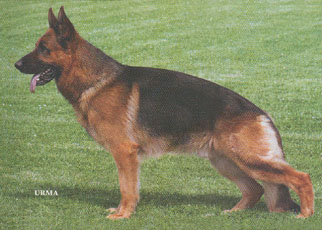
German Shepherd Dog, West German Show (High Lines). This is the breed type most popular in Germany, and which at its best probably comes closest to the Breed Standard. Representatives of this family can be successful show and breeding dogs, and still perform as herding, service, SAR and guide dogs, as well as reliable companions and sport dogs. They are shown world wide under the German SV system, which requires working titles of show and breeding dogs.They are predominantly black and red in colour, and exhibit a fluid, ground eating trot. Shortcomings which are most typical of this family are roached backs, fading pigmentation and weak temperament. VA1 Yasko v Farbenspiel SchH3 Kkl1

German Shepherd Dog, German Working Lines (also Belgian and Dutch lines, which are NOT related to Belgian or Dutch shepherds, which are different breeds – see below). These dogs have been bred primarily for the sport of Schutzhund, and as service dogs. They excel as police, military, SAR and drug/bomb detection dogs. If you seriously want a working dog, or one that can be competitive in sport, these are the lines you would consider first. They are less likely to show the elegant conformation typical of show lines, but many, like the dog illustrated, show excellent structure, and they are powerful and athletic. Sable, black and bicolour are typical, although black & tan is also common. Some show more drive and aggression than would be wanted in a family or guide dog, although there are many more that are suitable for any purpose.V Buster v Adelmannsfelderland SchH3 Kkl1

German Shepherd Dog, East German Lines (DDR). This family was developed in East Germany from those dogs remaining in the East after WW 2. Those foundation dogs predated the show/working split of post-war West Germany, and were not extreme in either conformation or drive. The DDR dogs tend to show solid working structure with heavy bone and massive heads, and strong temperament. Some dogs can show a degree of sharpness. Overall, they tend to be very sound. Some breeders are attempting to preserve the pure DDR lines, but they are more commonly being integrated into the working lines with good success.SG Alk v Osterburg Quell SchH3 DPO2 WPO Kkl1
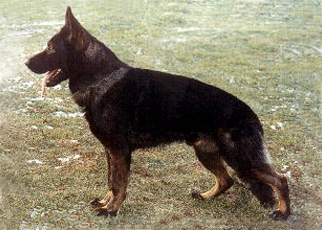
German Shepherd Dog, Czech/Slovak Lines. These dogs were bred in Communist Czechoslovakia as state working dogs. They are essentially the same as the DDR lines, from which they were largely developed. Similarly, some breeders are attempting to preserve the pure Czech dogs, but they are more commonly being integrated into the working lines with good success.
Gent od Policie SchH3 IPO3 ZVV3 Kkl1
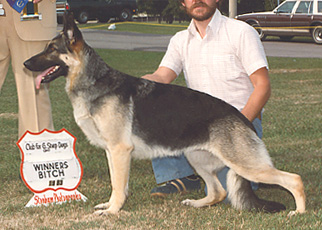
German Shepherd Dog, American Show Lines. This family has been the numerically dominant type in North America since the 1970’s. The entire family is heavily inbred on one extraordinarily successful show and stud dog at that time, GV Lance of FranJo. They are shown under the American & Canadian Kennel Club systems, which require no working titles or hip certification. In general, they are bred for an extreme trotting structure often showing excessive length of body and rear angulation. Unfortunately, the extreme physical type wanted by specialty judges is not conducive to the speed and jumping ability required of a working dog. Temperament is generally soft, and drive is variable. Weak nerves are a problem, as are other health issues. Recently, some breeders are showing more interest in obedience, herding and agility tests.Hip status is generally good. At their best, members of this family, if not extreme, can be fine family and obedience dogs.CH Hermsdorf’s Highland Wind CD, owned by Linda J Shaw
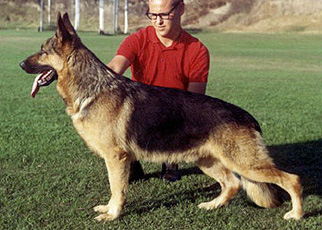
Old American Show generally refers to American show dogs bred prior to the 1970’s, which did not show the extremes of the later bloodlines, and whose bloodllines largely died out with the appearance of the modern American show lines. At the same time in Germany, the breed had not yet differentiated into show and working lines, and in type were very similar to the American dogs. Dogs like Marko Cellerland and Bernd and Bodo Lierberg were great show dogs, and great producers of show, working and sport dogs as well. German dogs won in the American show ring and produced American champions. American dogs produced many service dogs in use in North America. There were no extremes of physical type or temperament.GV CH Yoncalla’s Mike
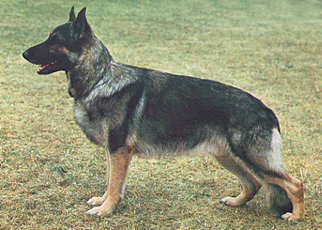
German Shepherd Dog, British Lines (Alsation). These dogs are descended from old lines imported into the British Isles prior to the modern, post-war German lines. They developed into a heavy boned, long bodied type with uniformly beautiful shoulders, showing generally soft temperament and variable drive. They did find usefulness as police service dogs and guide dogs, but with the relaxation of English quarantine laws, they are being supplanted in service by modern German working lines, and in the show ring by modern German show lines.CH Shootersway Xanthos of Colgay

Crosses between types are as good or as bad as the animals used to make the cross. They generally do not show the extremes of either parent’s type. Shown is a first generation DDR X Canadian show cross, the product of a Group winning show champion (Ch Corry, pictured in the Page Heading) and a bitch of Haus Kuhn breeding. He is my homebred male, Tim, and the most stable, reliable dog I have ever known. He is living proof that a GSD can have high drive and strong aggression, and still be a wonderful companion, gentle with small children and friendly with people. He has made friends for the breed where ever he went.Shawlein Easter Parade SchH3 AD CD TD TT CGC UCC OFA, CH ptd. Bred, trained and owned by Linda J Shaw
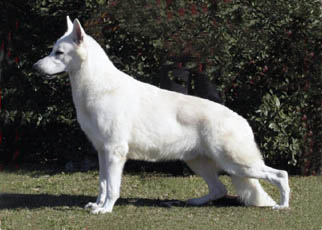
German Shepherd Dog, White (Swiss Shepherd Dog). White is a dominant masking gene that is a disqualification in most countries. Lovers of the white GSD campaigned for equal recognition, but finally pursued separate breed status and gained FCI recognition as the Swiss Shepherd Dog. In North America they are still AKC/CKC registered as GSDs, or are recognized by ARBA as Canadian or American White Shepherds. In general, they show good but somewhat oversized structure and medium to soft temperament, with variable drive. They have served as SAR, therapy and guide dogs, where white can be an effective colour. The white gene is not linked to deafness or any health problems, and is not albinism. They should show dark eyes and skin, and black nose, lips, pads and nails.CH Alhambra´s Fox Mulder, world’s all time top winning white. BazilianYoung Champion, Br.CH, Br.Grnd CH, Pan American CH, Grnd CH Pan-American, CH Argentino, Grnd CH Argentino, CH Américas y Caribe,CH Latin American, Int’l CH, World Champion 2004 & 2005.
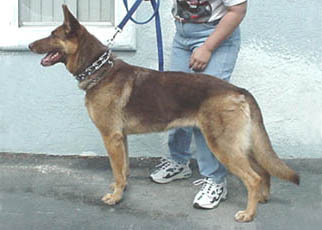
There are no “rare” or especially desirable colours in the correct GSD. Blue and liver are disqualifications world wide. Silver, fawn, cream and solid red dogs are examples of extremely faded pigmentation. Breeders who promote odd colours are not breeding to the GSD Breed Standard, although their animals may be perfectly sound and make fine companions. Interbreeding animals with insufficient pigmentation can result in dogs with skin problems, and lightly pigmented exposed skin which is not well protected from UV radiation. Pictured is a liver and tan GSD.

Shiloh Shepherd. A breed developed in America as a reaction to the increasingly extreme show type, in a supposed attempt to recreate the qualities of the “original” GSD. Alaskan Malamute and Sarplaninac were crossed in to increase size. This is a giant breed, at least 30″ at the shoulder. It is not AKC recognized, but is registered with the ISSR, or International Shiloh Shepherd Registry. All colours and long coats are accepted. Ears are slightly smaller than the GSD. Temperament is medium to soft and drive is variable. Although its giant size and soft temperament make it unsuitable as a police service dog, it is an intelligent and sensitive breed that can make a fine companion, family and therapy dog.
Acer’s Royal Flush of Zion
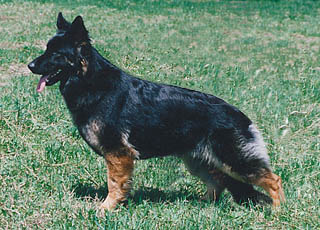
German Shepherd Dog, Long Haired (Alt Deutsche Schaferhund, “Old German Shepherd Dog”). This is not a separate type or breed. The recessive gene for long hair is present in all families and types, and results in a longer than normal coat. It can vary from slightly longer than normal, to very long hair which is difficult to keep well groomed and free of burrs and ice. The long coat is a fault, and cannot be shown in Germany. As a result, a separate breed club has been created to promote the long haired shepherd in Europe as the “Old German shepherd”, although they appear to be untitled dogs of no particular bloodline, and are not bredor titled for work (although there are working bred coated dogs who have done extremely well in Schutzhund and service work). A coated dog bred to a dog that is free of the recessive will produce normal puppies who carry the recessive.
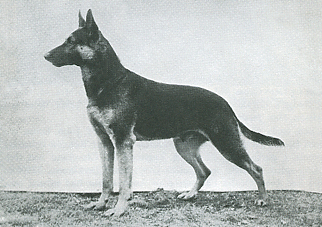
This is the true “German Old Style”, a Sieger from the 1920s. The dog’s dry bone, leg length, shallow chest and square proportions make the breed’s kinship with the northern Malinois quite apparent. The breed’s founder decided that a more powerful dog was wanted, with a lower stationed, trotting structure that was not so massive as to detract from the dog’s speed and agility. These early dogs are the breed’s foundation and history, but breeders have developed better dogs than this, and there is no good reason to return to the past.
VA1 Erich v Grafenwerth
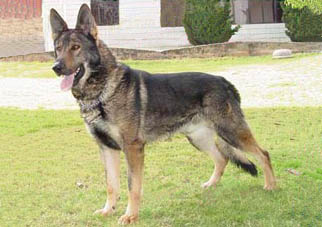
Kunming Dog. An interesting attempt to recreate the GSD in Communist China, but with the square, leggier structure of the very early GSD. They can show a tendency to weediness. Colours include all GSD patterns, as well as brindle apparently. This breed was created to supply military dogs in Yunnan province, of which Kunming is the capital. It was founded in the 1950’s on the blood of 10 Beijing military “wolf dogs”, likely of GSD descent, 20 tested local dogs and 10 GSDs from Germany. They serve widely in China as police and military dogs, as well as SAR dogs. Although they have lost the beautiful trotting structure of the GSD, they are medium in size, close coated and selected for temperament. How they compare in ablity to the best working bloodlines in the West remains to be seen, but they are reputed to make fine companions, and overall would seem to show good stability and trainability.
